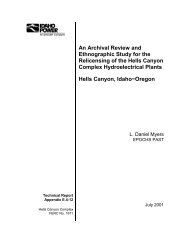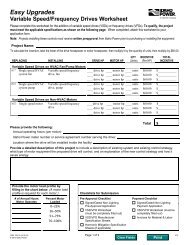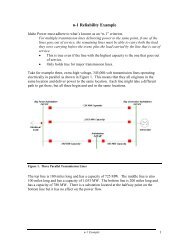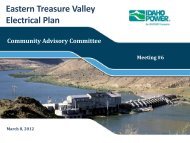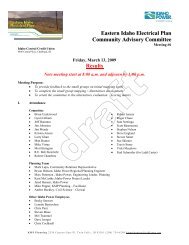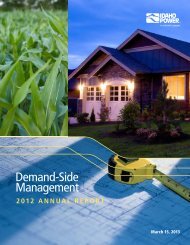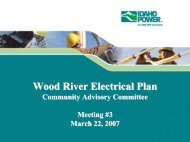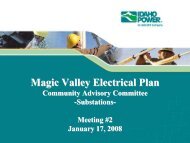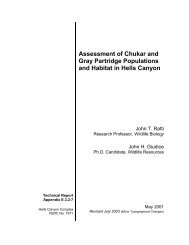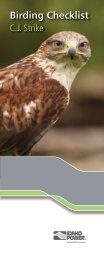Shoshone-Bannock Tribes - Idaho Power
Shoshone-Bannock Tribes - Idaho Power
Shoshone-Bannock Tribes - Idaho Power
Create successful ePaper yourself
Turn your PDF publications into a flip-book with our unique Google optimized e-Paper software.
<strong>Idaho</strong> <strong>Power</strong> CompanyResponses to Commentsthrough a telephone call to the Native American representative(s), followed up by a letter orcertified letter. The Native American tribe(s) will have 30 days to review the proposed action andexpress its/their concerns (cf. 36 CFR 800.3[c][4]).If the action is on state land, the cultural resources manager will also consult with the <strong>Idaho</strong>and/or Oregon SHPO, which will have 30 days to express concerns, as well as determinewhether Native Americans have an interest in the proposed action (cf. 36 CFR 800.3[c][4]). Ifthe proposed action is on federal land, the cultural resources manager will consult with the <strong>Idaho</strong>and/or Oregon SHPO, which will have 30 days to express concerns, and also with the federalagency affected (e.g., the BLM or USFS), which will have the same 30 days (cf. 36 CFR800.3[c][4]). The federal agency will conduct consultation with the appropriate Native Americantribe(s), as this would enter the realm of government-to-government consultation. The federalagency will have 45 days to express concerns, including soliciting and receiving input fromNative Americans.Following notification, interested parties, including IPC, will meet to discuss concerns, potentialeffects to cultural resources, and impact mitigation plans. Meetings may be by telephone, bye-mail, in person, or with a combination. As an example of consultation, during pre-licensingmeetings, the Cultural Resources Work Group (CRWG) developed a series of guidelines forrecommended actions should monitoring show that cultural resources are being adverselyaffected by river erosion.Consultation with the <strong>Idaho</strong> and Oregon SHPOs, tribal government representatives and staffmembers, traditional practitioners and elders, and agency representatives and staff members isintegrated into this management plan. Consultation is a mandated element of the FERCrelicensing process (HPMP, section 1.3.). Consultation includes both a specific and a generalapproach. See the HPMP, Appendix 4.3-a for a basic step-by-step standard procedure forhandling conflicts that could arise out of situations requiring consultation. As stated above, IPC’sphilosophy is not to abandon consultation, but to work through conflicts. An important first stepis to lay the groundwork for initial meetings through ongoing contacts so that potentiallyinterested parties are aware of proposed actions on the part of IPC. Parties with no interest in aspecific project can express this prior to engaging in time-consuming meetings, saving theirefforts for discussions that are relevant to their concerns. As described in the HPMP,section 4.3.8., consultation will precede unavoidable adverse effects on historic properties, aspart of the section 106 process required for all federal undertakings. It will also be a generalmethod of cultural resource management by IPC, wherein open lines of communication shouldhelp management practices run smoothly.RESPONSE TO COMMENT SBT1-189IPC contemplates that funds dedicated to the <strong>Shoshone</strong>-<strong>Bannock</strong> <strong>Tribes</strong> would be spent inconsultation with IPC. Actual expenditures will be approved by IPC. The proposed PM&Emeasures specifically indicate the types of activities that IPC will consider appropriate:1. Obtain funding for participating in and/or administering cultural resources PM&E measures,educate its youth by providing a scholarship/training fund, and provide funds to facilitateseveral cultural enhancement projectsHells Canyon Complex Page 77



